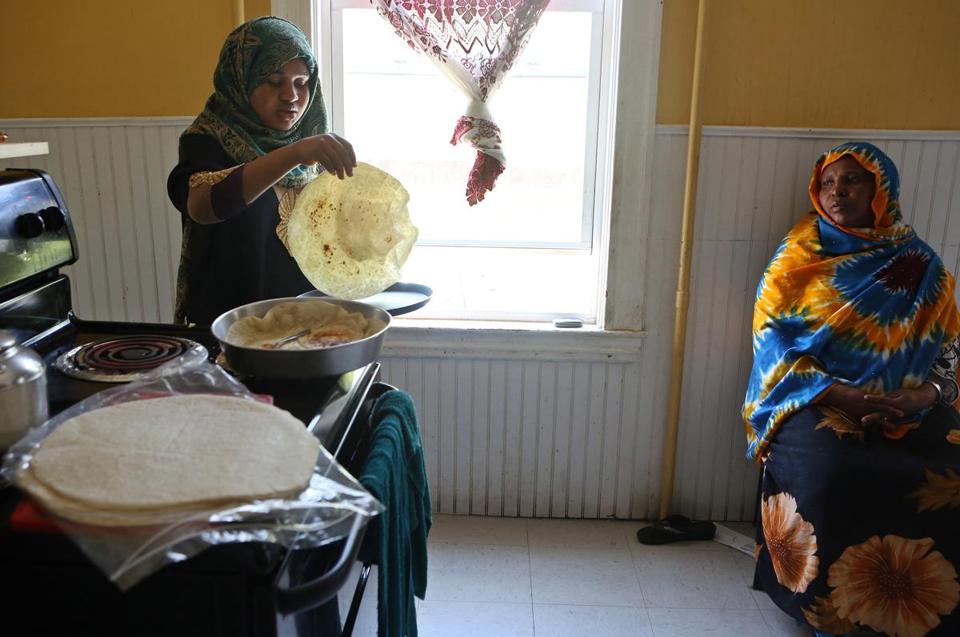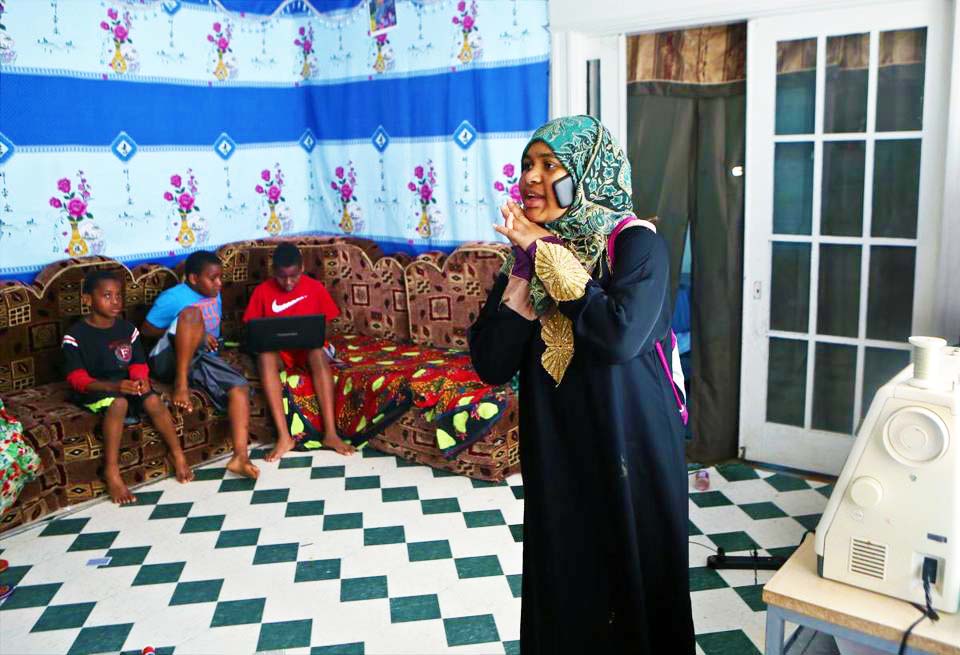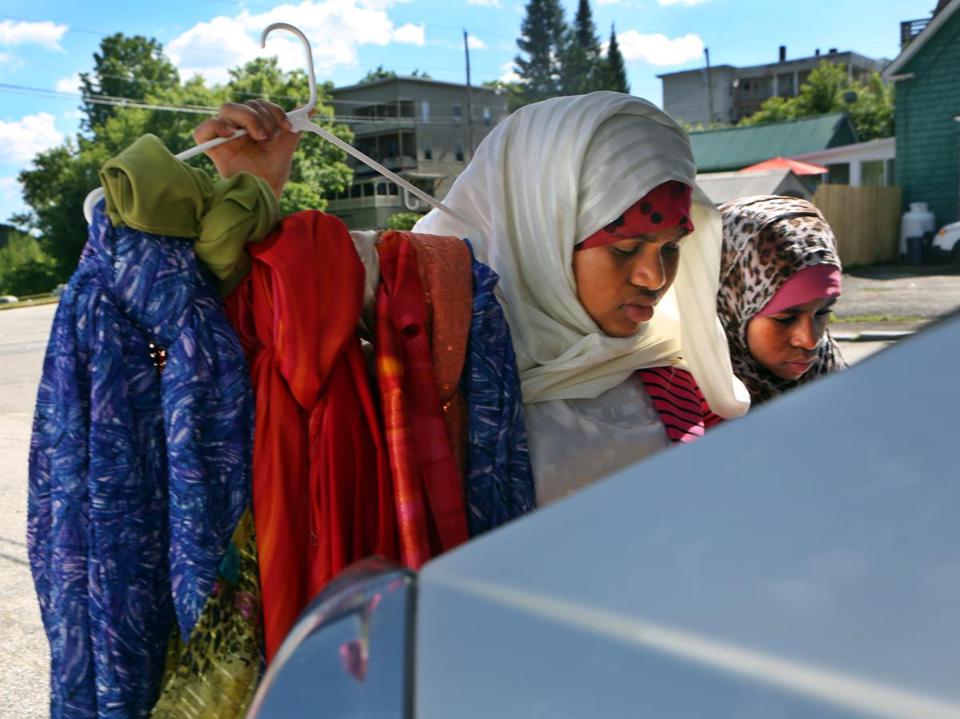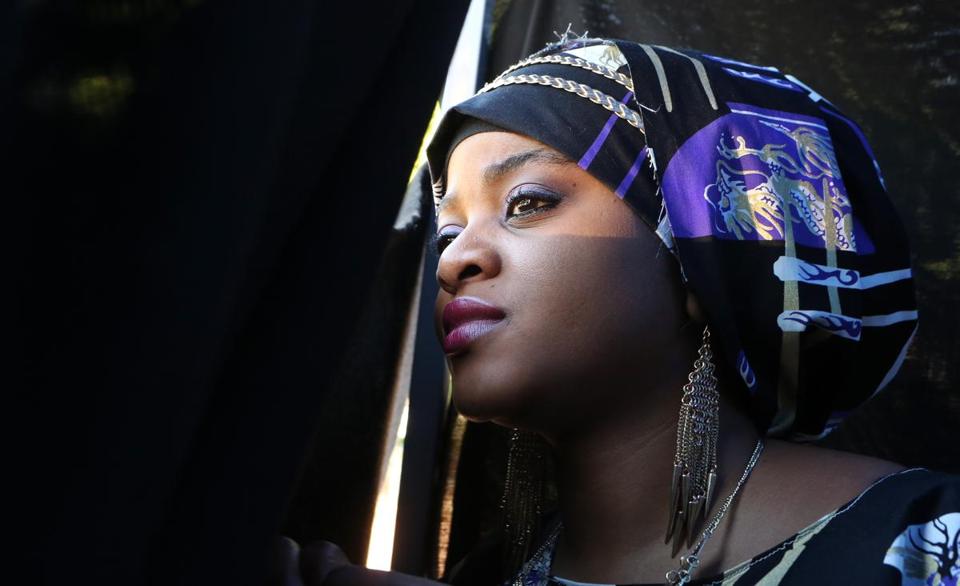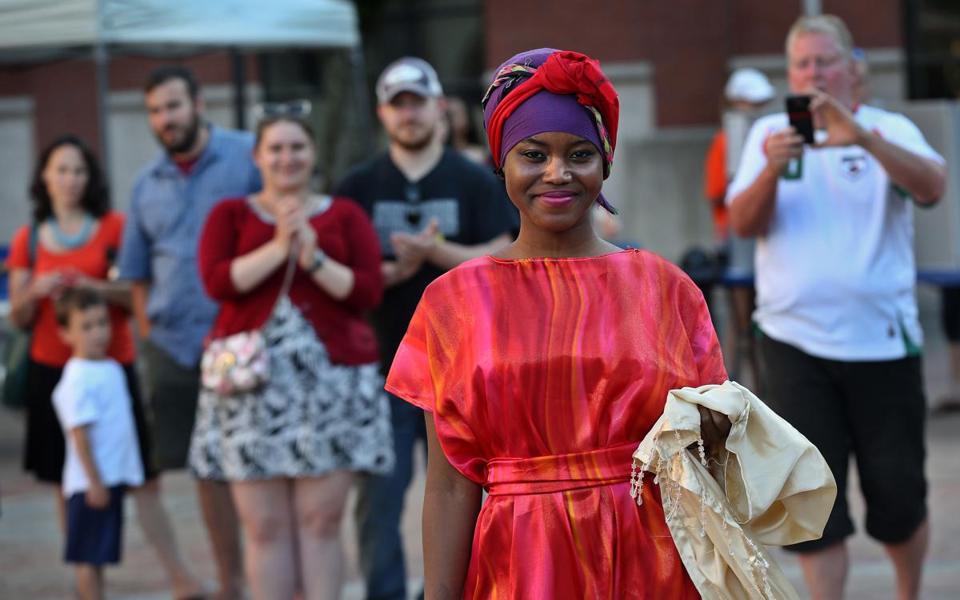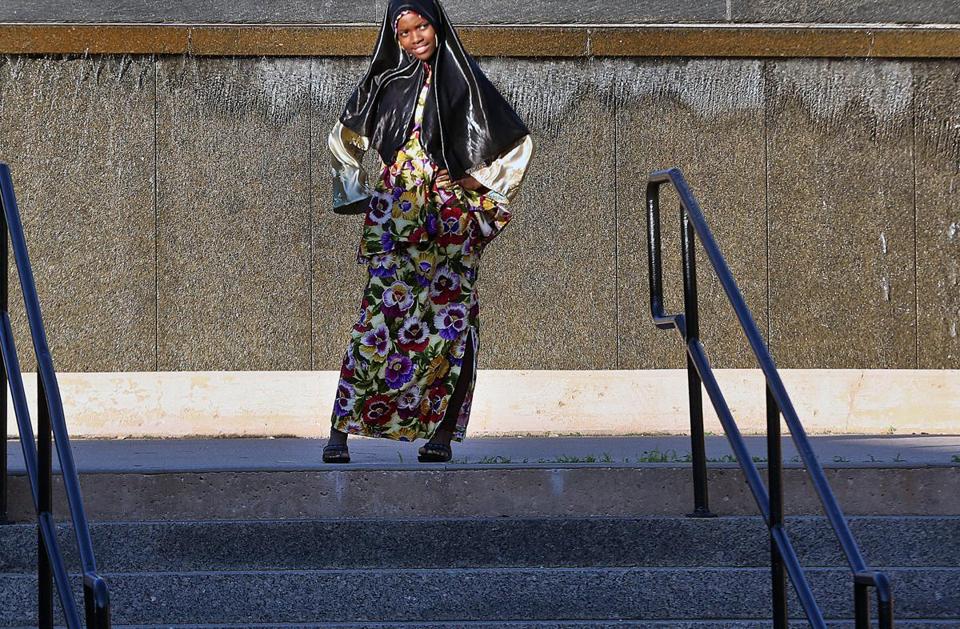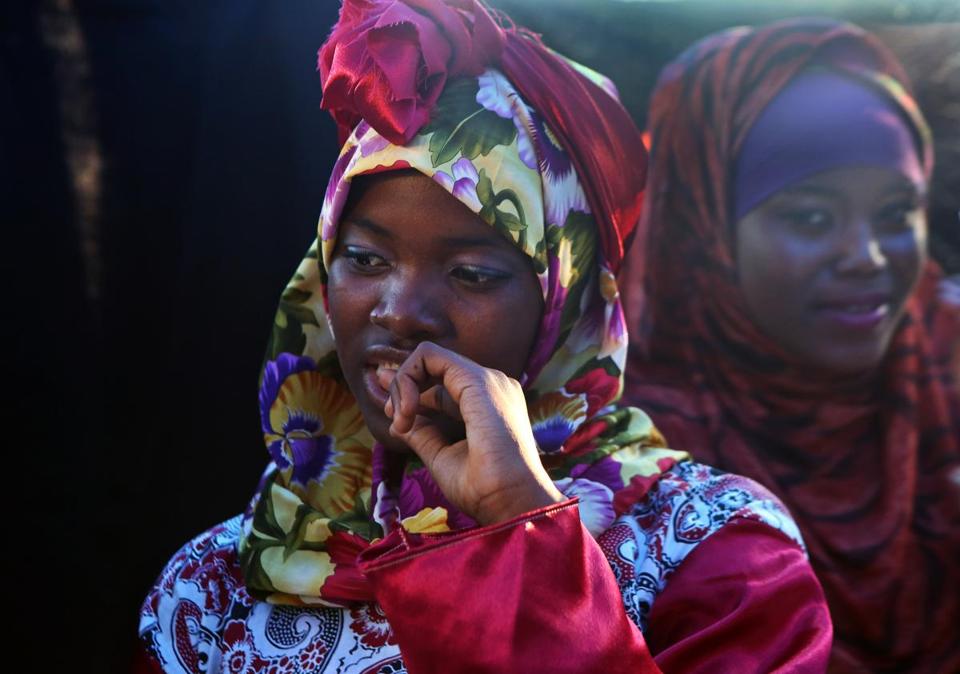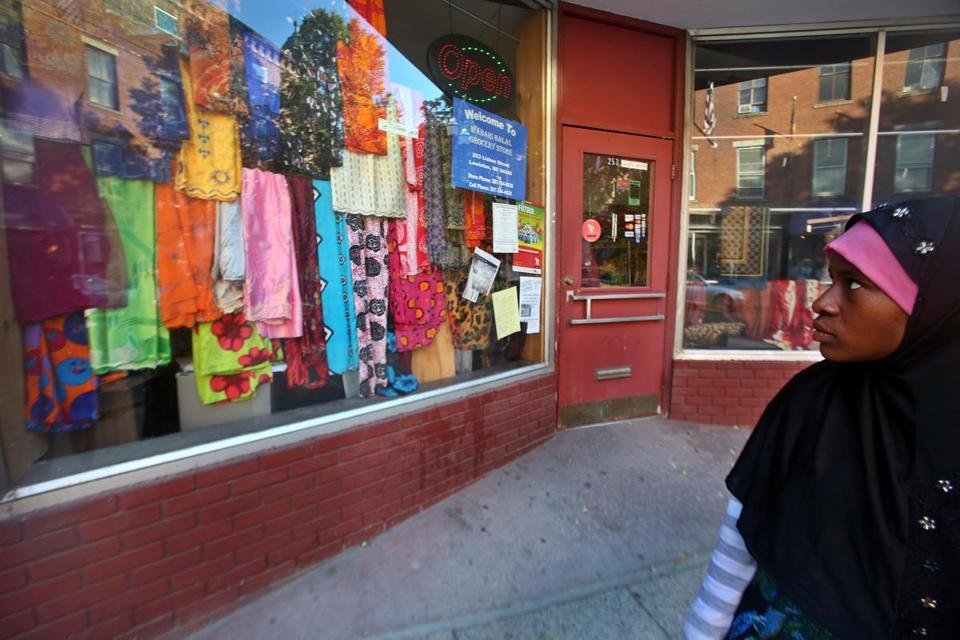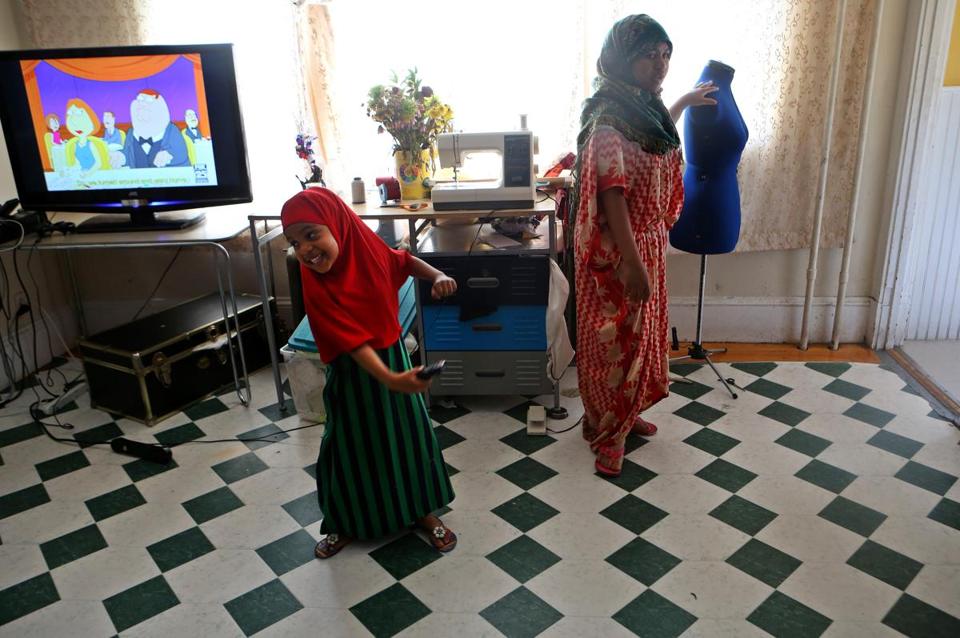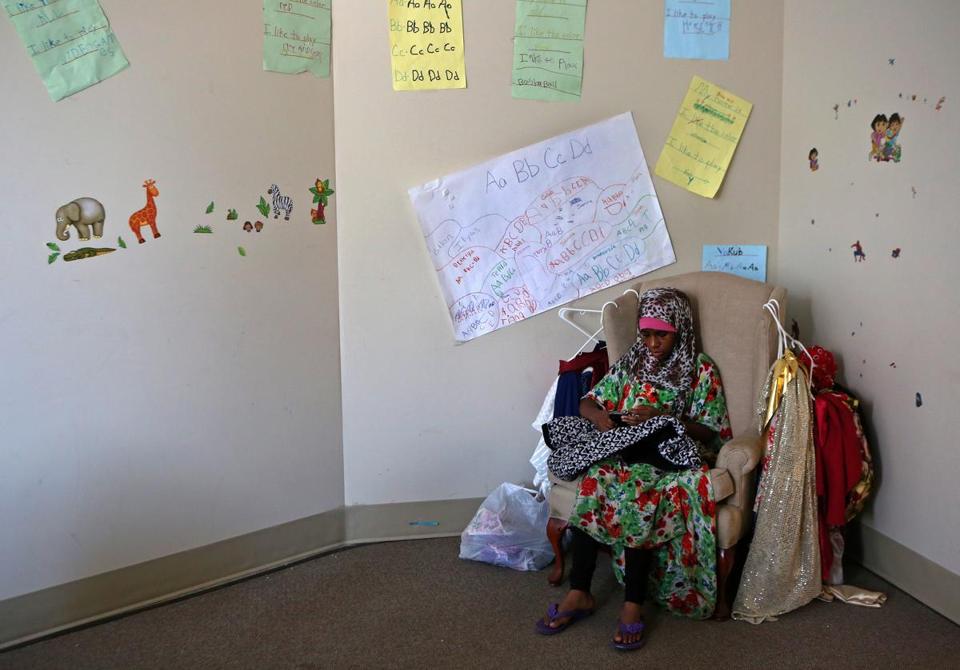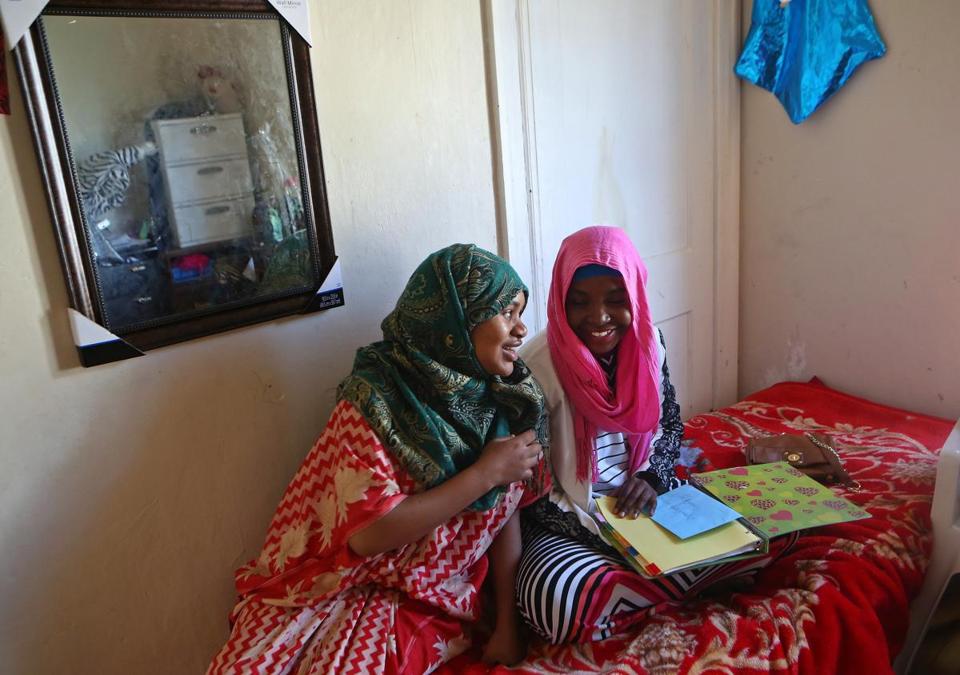LEWISTON, Maine — Sahro Hassan is a devout Muslim who prays five times a day. She is a fashion designer and budding entrepreneur who loves “America’s Next Top Model” and “Project Runway.” She is a change agent for her people and, in some ways, for her adopted hometown.
She is all of 18.
A self-proclaimed “Islamanista,” or Muslim fashionista, Hassan has set out to encourage other Muslim women to feel confident enough to express themselves through fashion. Why, she wonders, can’t a young woman be modest and stylish at the same time?
“I’m not doing fashion because I want to go away from my culture,” said Hassan, who is dressed headscarf-to-toe in leopard prints. “I’m doing fashion because I want to keep my culture and make sure the next generation of kids understand their culture.”
Hassan has had to bridge several worlds in her young life. Her Somali parents fled to Kenya in the early 1990s to escape the horrors of civil war, and she grew up in refugee camps. Her family moved to the United States when she was 10, which was difficult for Hassan, who didn’t know what the United States was when she left Africa. She spoke only one word of English (“hello”) and was illiterate in her native language.
Eight years later, Hassan has graduated from high school with honors. She has a business called Fashionuji and designs bold, edgy clothes for Muslim women that are “on trend,” she said, but modest enough to meet Muslim religious standards. She took first prize in Maine’s Future Business Leaders of America competition and the “Girls Rock Award” for entrepreneurship from Hardy Girls, Healthy Women, a Maine nonprofit. She just started a four-year fashion design program at Newton’s Mount Ida College.
By all accounts, she’s had an impact on this challenged city of 36,500. Perhaps inadvertently, she’s helped make the case for tolerance in a city that has made national headlines for intolerance.
“She’s been able to balance, standing on one foot in one culture and one in another, very eloquently,” said Julia Sleeper of Tree Street Youth, which serves at-risk youth here and is where Hassan learned to sew.
From Somalia to Maine
Lewiston was a mill town for more than a century, starting around the 1850s. Powered by the Androscoggin River and a surge of French Canadian immigrants, Lewiston was one of the largest textile producers in New England, rolling out millions of yards of cotton fabric every year. In time, though, the industry struggled to compete with Southern states where production costs were lower. Lewiston slid into decline. “By the 1980s, the mills were all but gone,” said Phil Nadeau, Lewiston’s deputy city administrator.
The next two decades were sad years. Houses were vacated. Store fronts emptied. Mills shut down.
Today, the city is being revitalized. The Bates Mill complex houses a TD Bank call center, loft apartments, a museum, and restaurants. There’s a park for concerts, art walks, and plans for an amphitheater.
But things took an unexpected turn in February 2001, when a few Somali families moved to Lewiston and liked what they saw — cheap housing, good schools, and safer streets than cities like Atlanta, Chicago, and Memphis, where many Somalis had been assigned by refugee agencies.
Over the next few years, thousands of Somalis came to Lewiston. Currently, there are some 5,000 immigrants living here, about 85 percent of them Somali, according to City Hall data.
Lewiston, the state’s second-largest city, was transformed.
“The first halal store opened around the time a mosque opened,” said Nadeau, referring to shops that sell goat meat, tamarind juice, and other groceries permissible to consume under Islamic law. “I can’t even guess how many there are now. At least a dozen.”
The norm now is to see women with head scarves and long flowing dresses striding down the streets, children in tow. The scent of tamarind and cumin hangs in the air outside African restaurants. Prayer rugs are tucked into corners of shops.
A different kind of struggle
Not everyone in town has been happy about the Somali wave.
Some residents grumbled about the immigrants using welfare benefits. Locals called City Hall asking who “authorized” the influx, according to Nadeau. In 2002, then Mayor Laurier Raymond wrote an open letter urging the Somalis to stop inviting other immigrants to Lewiston.
There have been other incidents over the years. In 2006, a white man rolled the head of a pig, considered impure by Muslims, into a mosque. Two years ago, Lewiston’s current mayor, Robert E. Macdonald, told the BBC that immigrants should “accept our culture and leave your culture at the door.”
By the time they got to Lewiston, Sahro Hassan’s family had already had a taste of feeling unwelcome. They’d spent six unhappy months in Indianapolis.
“My school was not used to diverse people,” said Hassan, the oldest of eight children, ages 2 to 18. Once, she was summoned to the principal’s office and ordered to remove her hijab. “Our culture was literally being stripped away from us,” she said.
But Lewiston was different. There were lots of people from other countries, and lots of Somali Muslims. If she said “Salaam alaikum,” or “Peace be upon you,” to a stranger on the street, she’d usually be greeted right back.
When Hassan started school, there was a translator to help her; within a year she was proficient in English. Her father learned some English and got a job at Walmart, where he works six days a week, stocking shelves. He learned to drive a car.
But it was an overwhelming adjustment. In Somalia, she said, her parents were “just villagers” who fled their homeland because terrorists were slaughtering families, kidnapping girls.
They headed toward the Kenyan border. Many people died on the way, but nobody buried them. “Everybody just kept moving,” her mother, Habibo Sambul, said, as Hassan translated. They made it to a refugee camp, but that was little better.
They stayed there until humanitarian organizations resettled them in the United States where they would struggle in a different way.
“Oh my God, when I saw America, I was like, ‘What’s this?’ ’’ Hassan said. “If you want water, you don’t line up?”
She was amazed when teachers talked to her about going to college. In her own culture, women had children and stayed home. Yet she quickly soaked up American ways. Above all, she was intrigued by the way American women dressed — the vast range of colors and patterns, the fabrics.
Muslim clothing emphasizes modesty first and foremost, she said: head covered, clothes loose.
“My mother taught me if it isn’t comfortable, it isn’t modest . . . . No man will respect you if you wear tight clothes. She said, ‘Don’t dress for other people but for your religion and culture.’ ”
This was not so easy in America where dresses “had too much cleavage and were too tight,” she said. She covered up with cardigans. Still, she wondered, did Muslim clothing have to be so uninspired? To make her point, she walks through the clothing section of a halal store.
“Every single kid in town is wearing the exact same thing, except the color might be different,” said Hassan. “Everything is matchy-matchy.”
She began dressing so colorfully “you could see her from far away,” said her friend Shamsi Aden. “You’d say, ‘That’s Sahro!”
An idea dawns
Hassan first considered being a designer in middle school. She learned to sew at Tree Street Youth, and joined the Chamber of Commerce’s Young Entrepreneurs Academy. She wrote a business plan for a line of stylish clothes for Muslim women and called it Fashionuji, because Uji, her nickname, means oatmeal, “or as I like to define it, soft, naive, and beautiful,” Hassan said. She pitched the idea to local investors, who awarded her $1,100 to help launch her business; displayed her samples at a trade show; shopped them around to local stores; and organized two fashion shows.
Hassan also studied videos of fashion shows, then trained her girlfriends to be models: how to strut down a runway and pause for effect, how to stay composed and keep walking, even if there’s a glitch in the music.
She built a website, www.fashionuji.com, with her design samples, and rap-inspired poetry:
Some call us terrorist
Some think Muslim women are oppressed
To them the hijab is a trashy paper bag
They don’t gotta clue how we swag . . .
She learned the lingo of the fashion and business industries. The girl who eight years ago could not speak English now sprinkles her conversations with casual references to “show-stoppers” and “cost control.”
“I’ve been trying to get my cuts really clean,” she said of her latest collection. “I think I’ve nailed it this time.”
A future business leader
Sahro Hassan is barely 5 feet tall, has a round face and an impressive ability to multitask. At the moment, she’s in the kitchen of her family’s sparsely furnished four-bedroom apartment cooking Somali chapati, or flatbread, for two girlfriends who are hanging out in her bedroom. She is also translating for her mother, and talking on her cellphone which is tucked into her hijab.
The call is from her mentor and former middle school teacher Barbara McManus, who reminds Hassan to be at the airport at 5 a.m. for a flight to Tennessee. She’s representing Maine in the national competition of Future Business Leaders of America.
Hassan seems startled. She almost forgot.
“I’ll bring my resume and my business plan,” she tells McManus, recovering quickly.
The day isn’t shaping up well. She had spent the morning at her job at Lots to Gardens, a community garden program. (Some of her job earnings go to her parents to help with expenses.) Now, she’s running late for 1:30 prayer at the mosque. She hasn’t packed for her trip, and Ramadan starts that night, which means she’ll have to get up at 3:45 a.m. to eat a family meal before she starts her daily fast and rushes to the airport.
That evening is also her fashion show. She’s been working on the designs for weeks in what passes for her workroom: a corner of the living room, where the walls are covered with African fabric and a sofa imported from Mogadishu. Her sewing machine is a gift from an anonymous donor who left it for her at the youth center.
“I want you to have this sewing machine to help get your business started,” the note said. “I know you will be a success.”
The fashion show took place in a concrete plaza downtown with two sloping ramps sometimes used by skateboarders. Hassan, wearing red tights under a white dress and glittery accessories, nervously adjusted the models’ outfits inside a tent. One wore a flowing gold lame skirt over a red polka dot shirt, which complemented her hijab. Another paired a crimson dress with green shoes.
As the emcee described the outfits, a crowd gathered and grew. By the end, the plaza was packed with adults and children, most of them white, who were clearly delighted and stood to applaud.
Afterward, Hassan glowed. She was proud of her “girls” for looking so strong and proud. But the best part was when a little girl approached her.
“She said, ‘I’m a big fan of yours.’ To hear that from a little child? That is the most heartfelt piece for me,” Hassan said. “It says I’m inspiring not only Muslims but a little girl who is white to follow their dreams.”
Source: http://www.bostonglobe.com
